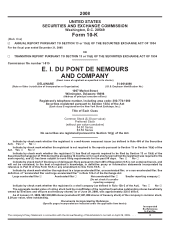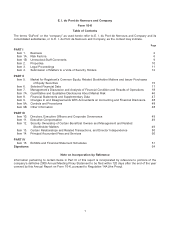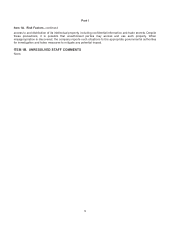DuPont 2008 Annual Report Download - page 7
Download and view the complete annual report
Please find page 7 of the 2008 DuPont annual report below. You can navigate through the pages in the report by either clicking on the pages listed below, or by using the keyword search tool below to find specific information within the annual report.Item 1. Business, continued
Competition
As a science and technology based company, DuPont competes on a variety of factors such as product quality and
performance or specifications, continuity of supply, price, customer service and breadth of product line, depending
on the characteristics of the particular market involved and the product or service provided.
Major competitors include diversified industrial companies principally based in the U.S., Western Europe, Japan,
China, Korea and India. In the aggregate, these competitors offer a wide range of products from agricultural,
commodity and specialty chemicals to plastics, fibers and advanced materials. The company also competes in
certain markets with smaller, more specialized firms who offer a narrow range of products or converted products that
functionally compete with the company’s offerings.
Agriculture & Nutrition sells advanced plant genetics through Pioneer, principally for the global production of corn
and soybeans and thus directly competes with other seed and plant biotechnology companies. Agriculture &
Nutrition also provides food safety equipment and soy-based food ingredients in competition with other major grain
and food processors.
Research and Development
The company conducts research in the U.S. at over 30 sites at either dedicated research facilities or manufacturing
plants. The highest concentration of research is in the Wilmington, Delaware area at several large research centers.
Among these, the Experimental Station laboratories engage in investigative and applied research, the Chestnut Run
laboratories focus on applied research and the Stine-Haskell Research Center conducts agricultural product
research and toxicological research to assure the safe manufacture, handling and use of products and raw
materials.
Other major research locations in the U.S. include Marshall Lab in Philadelphia, Pennsylvania, and Mt. Clemens in
Mt. Clemens, Michigan, both dedicated to coatings research; Pioneer research facilities in Johnston, Iowa; The
Solae Company facilities in St. Louis, Missouri; polymer research facilities in Richmond, Virginia, and Parkersburg,
West Virginia; and electronic technology research facilities in Research Triangle Park, North Carolina, Towanda,
Pennsylvania, and Santa Barbara, California.
DuPont, reflecting the company’s global interests, also operates more than 20 additional research and development
facilities at locations outside the U.S., with major facilities located in Sao Paulo, Brazil; Kingston, Canada; Shanghai,
China; Meyrin, Switzerland; Seoul, Korea; Wuppertal, Germany; and Utsunomiya, Japan. A new research and
development facility was opened in Hyderabad, India in 2008 to better serve the Asia Pacific market.
The objectives of the company’s research and development programs are to create new technologies, processes
and business opportunities in relevant fields, as well as to improve existing products and processes. Each segment
of the company funds research and development activities that support its business mission. Recently, the company
has broadened its sustainability commitments beyond environmental footprint reduction to include market-driven
targets for research and development investment. The company is expanding its offerings addressing safety,
environment, energy and climate challenges in the global marketplace by developing and commercializing
renewable, bio-based materials; advanced biofuels; energy-efficient technologies; enhanced safety and
protection products; and alternative energy products and technologies. The goals are tied directly to business
growth, specifically to the development of safer and environmentally improved products that enhance the
environmental profile of its traditional businesses for DuPont’s key global markets, including transportation,
building and construction, agriculture and food and communications.
The corporate research laboratories are responsible for conducting research programs aligned with corporate
strategy as provided by the growth segments. All research and development activities are administered by senior
research and development management to ensure consistency with the business and corporate strategy. The future
of the company is not dependent upon the outcome of any single research program.
Additional information with respect to research and development, including the amount incurred during each of the
last three fiscal years, is included in Item 7, Management’s Discussion and Analysis of Financial Condition and
Results of Operations, on page 21 of this report.
5
Part I




















